The Swedish Tourist Association recently announced a new service called The Swedish Number. People who dial +46 771 793 336 will be connected with a random participating Swede.
We talked to about a dozen of those Swedes with one question in mind: What happened on September 3rd, 1967?
Those who were alive and in-country during that time took little time to respond. That day was a national holiday of sorts: Dagen H (or “H-Day”), short for Högertrafikomläggningen (“the right-hand traffic diversion”). On that day, millions of Swedes switched from driving on the left side of the road to driving on the right.
It was the most massive overhaul in driving infrastructure that the world had ever seen.

Historically, the side of the road on which people walk, drive, or ride has varied from place to place. When horse-back was the primary mode of transit, people generally rode on the left side of roads so that their right hand remained free to greet oncoming riders—or to attack them with a sword.

But with the rise of horse-drawn carriage, conventions began to change. Drivers would often sit on on the left rear horse, so their dominant right hands could more easily control the rest of the team which stood to the front and right of the driver. It then made sense for them to drive on the right side of roads so the driver could be positioned in the middle of the lane and be able to more easily keep track of carriages behind them.
But this could vary by custom and country, and different locales had different norms. Cars began to replace horses, and they tended to go wherever local laws indicated that horse-drawn traffic should be.
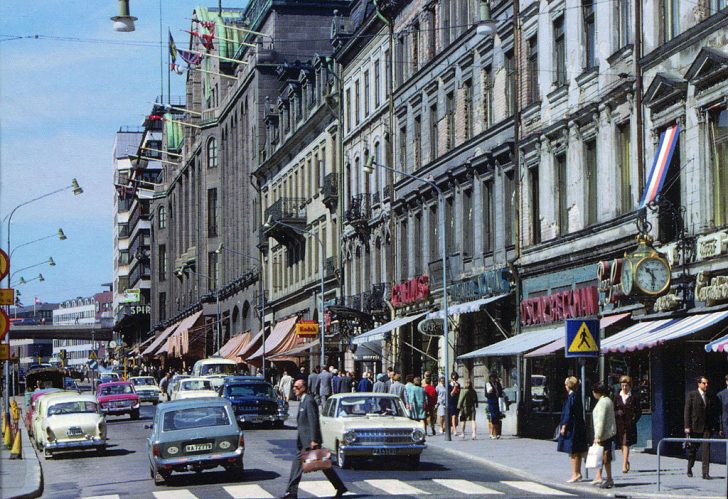
Until 1967, Sweden drove on the left—opposite from neighboring countries Denmark, Finland, and Norway. Swedish drivers who traveled abroad got into car accidents because of their unfamiliarity with the traffic patterns, as did tourists who came to Sweden.
Additionally, Swedish automotive companies made cars that were meant to be driven on the right so they could be more easily exported to the rest of the right-driving world, but many of these cars found their way onto Swedish roads. Swedish drivers were thus seated closest to the outside edge of the road, making visibility bad.
To combat these issues, the Swedish government made the case for switching to the right, and put the decision up for a public vote.
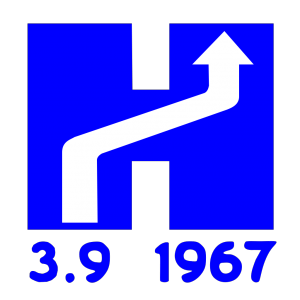 The response was overwhelmingly negative. People wanted to stick with what they were used to—but the government just decided to move forward with their plan anyway.
The response was overwhelmingly negative. People wanted to stick with what they were used to—but the government just decided to move forward with their plan anyway.
The Swedish government created entire departments to help with the transition. They designed signs and stickers featuring a new “H” logo (short for höger, or “right”). They distributed pamphlets and PSAs and created special products which included colored gloves and new headlamps all designed around the switch.
Sweden’s television station even held a contest to write the best song to help people remember the imminent switch. The winner, Håll dig till höger, Svensson (“Stick to the Right, Svensson”) by the Telstars, involved a bit of a double entendre—in Swedish, “keeping to the right” is shorthand for being faithful to your spouse, while “going left” means having an affair.
On September 3, 1967—H-Day—the country was ready.
In the hours leading up to the change-over, most cars were kept off the road for as construction crews switched the road signs and performed their final infrastructural tweaks. At 4:50am, a horn blared and a loudspeaker announced, Now is the time to changeover! The new road signs were revealed, and the cars re-routed to the opposite side.
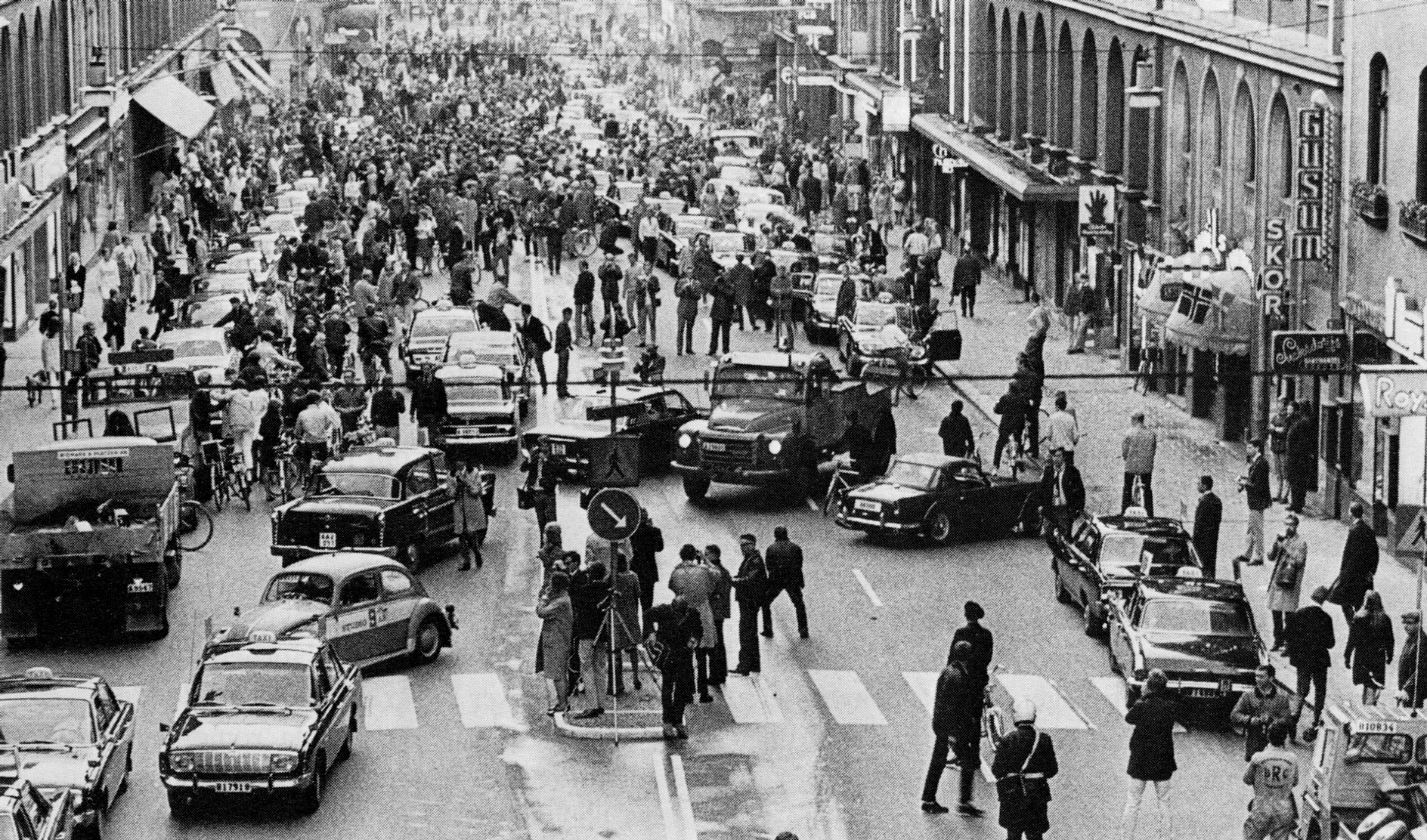
Remarkably, H-Day went very smoothly, thanks in part to drivers displaying excessive caution in the face of what was presumably a terrifying shift.
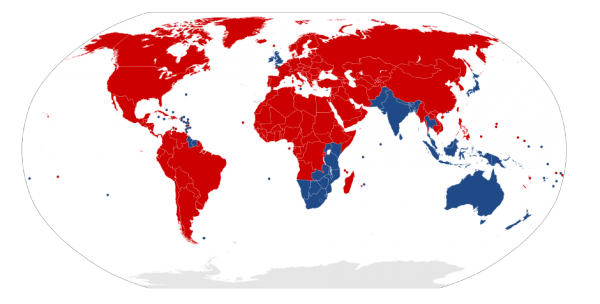
A year after Sweden switched sides of the road, Iceland also switched to driving on the right, and in the 1970s, former British colonies including Ghana and Nigeria switched from left to right to be more like their neighbors in West Africa.

Today, the vast majority of the world drives on the right, and in places that do drive on the left—such as the UK—movements occasionally spring up trying to get the country to switch to the right. Still, there is one notable exception to this trend.
In 2009, the island republic of Samoa did the reverse of what Sweden and so many others had done. They went from driving on the right, like most of the world, and switched to the left.
Moving to the left aligned Samoa with the three closest major economies: Australia, New Zealand, and Japan, all of whom drive on the left. By making the switch, they could then import used cars from Japan, which are has one of the cheapest used car markets in the world.
The Samoan declared the date of the change, September 8, 2009, a holiday in order to get people comfortable with the switch. (Like Sweden, Samoa also wrote its own song about the switch.)
The right-to-left transition went smoothly, largely because Samoa only has a few major roads. The country also experienced a dip in accidents afterward, probably because it got people to drive a little more carefully as everyone got used to keeping to the left.

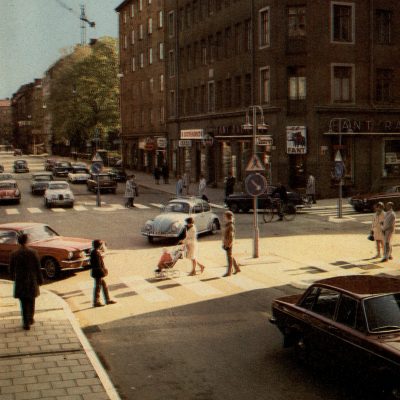





Comments (6)
Share
I think that Burma may hold the distinction of “most massive overhaul in driving infrastructure” thanks, some surmise, to some astrologic advice (move to the right) given to the dictator in control in 1970. I’m sure it was not nearly as orderly as Sweden – there are still public buses imported from Japan that dump passengers out into the drive lanes.
What, no mention of Nana San Maru?
https://en.m.wikipedia.org/wiki/730_(transport)
tl;dr: Okinawa was occupied by the US after WW2, so it switched to right-hand drive. When the US handed Okinawa back over in the 70s, Okinawa reverted to left-hand drive.
Used Japanese cars built to drive on the Left side of the road, are shipped to Bolivia where they go through the steering-wheel switch to hide among the cars built for Right hand-side driving.
http://www.la-razon.com/index.php?_url=/economia/DS-impidio-chutos-ingresen-Bolivia_0_1407459270.html
These cars have the nickname “chutos” which means “cheap” or “of bad quality”. They’re popular mainly for their price point vs. a new car and are often used as Taxis. You may recognize a “chuto” next time you take a taxi in La Paz and sit next to the driver, where you may find a rare panel without a glove comparment… now THAT’S a chuto “chuto” ;-)
What a clever conversion. The use of music to spread the message reminds me of Australia’s own song to inform people of the change of currency from British pound to the Australian dollar. Of course, the Swedish song is a million times catchier then ours.
https://www.youtube.com/watch?v=hxExwuAhla0
Did the switch take place at 4:30 in the morning? Really? The picture from Kungsgatan lets me think that must have been in the afternoon.
Many of the assertions in this piece seem to likely to be from single sources and at best only part of the picture. Sweden’s car manufacturers made cars to be driven on the right, while the country drove on the left. Really? In the UK Volvos and Saabs – Swedish makes – have been very common for a very long time, well before 1967. Is it not possible that they were made both right and left hand drive? Like, well, just about every car model mass produced in Europe and Japan, ever. Sweden changed because of all the car accidents Swedish drivers had when driving overseas. Really? So there’s a terrible accident rate amongst Brits driving in Europe and amongst lorries driven by Europeans in the UK? Really? Have you ever driven a car on the “wrong” side of the road? (Actually gave you ever been outside of the USA might be a better question). It really ain’t that hard. Hmmm. Dubious and a bit weak.